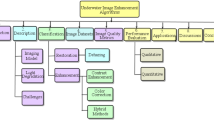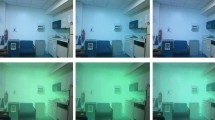Abstract
Acquisition of sensor data in wireless sensor networks with compressive sensing reduces the cost involved with sensing and communication. The challenge behind this work in underwater environment is exploring the fact of transfer capability of sensor nodes and underwater channel. The robustness of compressive sensing scheme in underwater environment is further augmented by recovery and transfer path. Two algorithms have been proposed. The first which uses compressive sensing at source and reconstruct using orthogonal matching pursuit at sink named as Underwater Wireless Information Transfer with Compressive sensing. Second algorithm exploits bandwidth estimation exploiting the cross traffic at intermediate forwarders for each source sensors to its associated sink named as: Underwater Wireless Information Transfer with Compressive sensing Bandwidth Measurements. Performance metrics of both protocols are interpreted through simulations.



Similar content being viewed by others
References
Wang, Q., Hempstead, M., & Yang, W. (2006, September). A realistic power consumption model for wireless sensor network devices. In 2006 3rd annual IEEE communications society on sensor and ad hoc communications and networks (Vol. 1, pp. 286–295). IEEE.
Donoho, D. L., Elad, M., & Temlyakov, V. N. (2006). Stable recovery of sparse overcomplete representations in the presence of noise. IEEE Transactions on Information Theory,52(1), 6–18.
Li, X., Wang, C., Yang, Z., Yan, L., & Han, S. (2018). Energy-efficient and secure transmission scheme based on chaotic compressive sensing in underwater wireless sensor networks. Digital Signal Processing,81, 129–137.
Zhao, R., Long, H., Dobre, O. A., Shen, X., Ngatched, T. M., & Mei, H. (2019). Time reversal based MAC for multi-hop underwater acoustic networks. IEEE Systems Journal.,13(3), 2531–2542.
Domingo, M. C., & Prior, R. (2008). Energy analysis of routing protocols for underwater wireless sensor networks. Computer communications,31(6), 1227–1238.
Wan, L., Zhou, H., Xu, X., Huang, Y., Zhou, S., Shi, Z., & Cui, J. H. (2013, November). Field tests of adaptive modulation and coding for underwater acoustic OFDM. In Proceedings of the eighth ACM international conference on underwater networks and systems (p. 35). ACM.
Berger, C. R., Zhou, S., Preisig, J. C., & Willett, P. (2009, May). Sparse channel estimation for multicarrier underwater acoustic communication: From subspace methods to compressed sensing. In OCEANS 2009-EUROPE (pp. 1–8). IEEE.
Xu, Z., Zhang, L., Shen, J., Zhou, H., Liu, X., Cao, J., et al. (2019). MRCS: Matrix recovery-based communication-efficient compressive sampling on temporal-spatial data of dynamic-scale sparsity in large-scale environmental IoT networks. EURASIP Journal on Wireless Communications and Networking,2019(1), 18.
Xu, Y., Sun, G., Geng, T., & He, J. (2019). Low-energy data collection in wireless sensor networks based on matrix completion. Sensors,19(4), 945.
Kong, L., Xia, M., Liu, X. Y., Wu, M. Y., & Liu, X. (2013, April). Data loss and reconstruction in sensor networks. In 2013 proceedings IEEE INFOCOM (pp. 1654–1662). IEEE.
Singh, V. K., Verma, S., & Kumar, M. (2019). ODECS: An on-demand explosion-based compressed sensing using random walks in wireless sensor networks. IEEE Systems Journal,13(3), 2466–2475.
Jahanshahi, J. A., Danyali, H., & Helfroush, M. S. (2019). A modified compressed sensing-based recovery algorithm for wireless sensor networks. Radio Engineering,28(3), 610–617.
Gan, H., Xiao, S., Zhang, Z., Shan, S., & Gao, Y. (2019). Chaotic compressive sampling matrix: Where sensing architecture meets sinusoidal iterator. Circuits, Systems, and Signal Processing, 1–22.
Wang, B., Ge, Y., He, C., Wu, Y., & Zhu, Z. (2019). Study on communication channel estimation by improved SOMP based on distributed compressed sensing. EURASIP Journal on Wireless Communications and Networking,2019(1), 121.
Erdem, H. E., Yildiz, H. U., & Gungor, V. C. (2019). On the lifetime of compressive sensing based energy harvesting in underwater sensor networks. IEEE Sensors Journal,19(12), 4680–4687.
Lin, Y., Tao, H., Tu, Y., & Liu, T. (2019). A node self-localization algorithm with a mobile anchor node in underwater acoustic sensor networks. IEEE Access,7, 43773–43780.
Wu, F. Y., Yang, K., Duan, R., & Tian, T. (2018). Compressive sampling and reconstruction of acoustic signal in underwater wireless sensor networks. IEEE Sensors Journal,18(14), 5876–5884.
Sun, T., Li, J., & Blondel, P. (2019). Direct under-sampling compressive sensing method for underwater echo signals and physical implementation. Applied Sciences,9(21), 4596.
Engmann, F., Katsriku, F. A., Abdulai, J. D., Adu-Manu, K. S., & Banaseka, F. K. (2018). Prolonging the lifetime of wireless sensor networks: A review of current techniques. Wireless Communications and Mobile Computing,2018, 1–22.
Anand, J. V., & Titus, S. (2014, October). Regression based analysis of effective hydrocast in underwater environment. In TENCON 2014–2014 IEEE region 10 conference (pp. 1–6). IEEE.
Anand, J. V., & Titus, S. (2017). Energy efficiency analysis of effective hydrocast for underwater communication. International Journal of Acoustics & Vibration,22(1), 44–50.
Pu, L., Luo, Y., Mo, H., Le, S., Peng, Z., Cui, J. H., et al. (2015). Comparing underwater MAC protocols in real sea experiments. Computer Communications,56, 47–59.
Le, S. N., Peng, Z., Cui, J. H., Zhou, H., & Liao, J. (2013, November). SeaLinx: A multi-instance protocol stack architecture for underwater networking. In Proceedings of the eighth ACM international conference on underwater networks and systems (p. 46). ACM.
Otnes, R., van Walree, P. A., Buen, H., & Song, H. (2015). Underwater acoustic network simulation with lookup tables from physical-layer replay. IEEE Journal of Oceanic Engineering,40(4), 822–840.
Ibrahim, M., Iqbal, M. A., Aleem, M., & Islam, M. A. (2018). SIM-cumulus: An academic cloud for the provisioning of network-simulation-as-a-service (NSaaS). IEEE Access,6, 27313–27323.
Aceto, G., Persico, V., Pescapé, A., & Ventre, G. (2017, June). Sometime: Software defined network-based available bandwidth measurement in monroe. In 2017 network traffic measurement and analysis conference (TMA) (pp. 1–6). IEEE.
Xie, P., Zhou, Z., Peng, Z., Yan, H., Hu, T., Cui, J. H., & Zhou, S. (2009, October). Aqua-Sim: An NS-2 based simulator for underwater sensor networks. In OCEANS 2009 (pp. 1–7). IEEE.
Ribeiro, V. J., Riedi, R. H., & Baraniuk, R. G. (2004, June). Spatio-temporal available bandwidth estimation with STAB. In ACM SIGMETRICS performance evaluation review (Vol. 32, No. 1, pp. 394–395). ACM.
Author information
Authors and Affiliations
Corresponding author
Additional information
Publisher's Note
Springer Nature remains neutral with regard to jurisdictional claims in published maps and institutional affiliations.
Rights and permissions
About this article
Cite this article
Arunkumar, J.R., Anusuya, R., Sundar Rajan, M. et al. Underwater Wireless Information Transfer with Compressive Sensing for Energy Efficiency. Wireless Pers Commun 113, 715–725 (2020). https://doi.org/10.1007/s11277-020-07249-7
Published:
Issue Date:
DOI: https://doi.org/10.1007/s11277-020-07249-7




